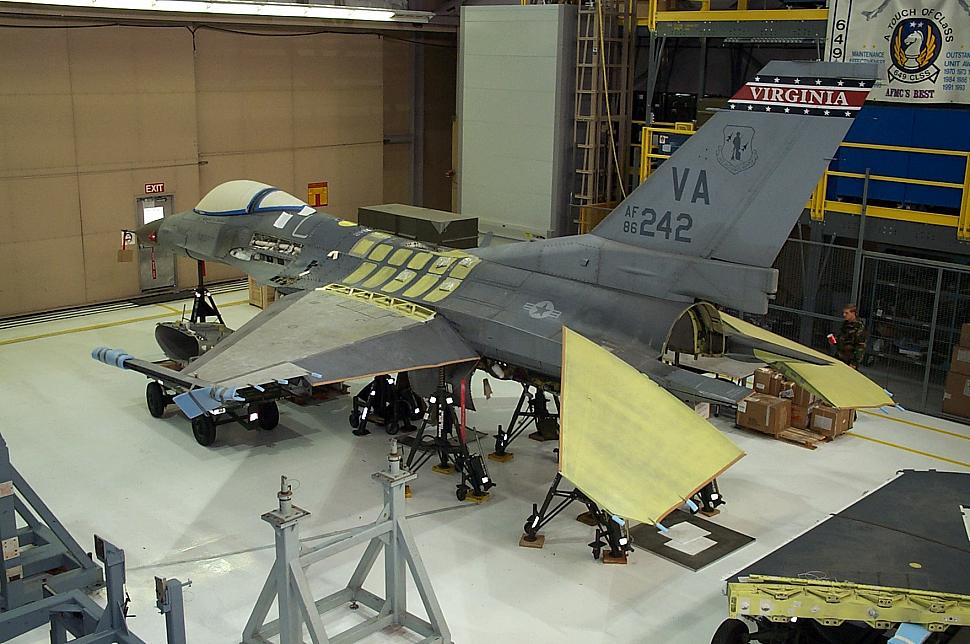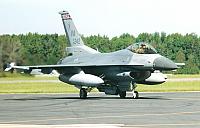Fighter Jet News
F-16 Fighting Falcon News
Hill team gives F-16 second life
May 11, 2006 (by
G. A. VolB) -
It was a long time in coming, but the completion of an F-16 damaged in an accident at Hill AFB December 2000 will save taxpayers tens of millions of dollars.
Originally in for depot modifications to extend the service life of the aircraft, the Virginia Air National Guard Fighting Falcon experienced an involuntary gear retraction during a test flight. F-16C #86-0242 landing gear collapse resulted in the aircraft skidding down the runway on its gear doors, ventral fins and airframe on December 26, 2000.
"Initially we were going to rebuild the intake and replace the keel beam and two bulkheads," said Master Sgt. Ron Zipperer, 649th Combat Logistics Support Squadron production dock chief. The team acquired an intake from the Aerospace Maintenance and Regeneration Center in Tucson, Ariz., but it didn't align with the fuselage - the team determined that the fuselage was twisted in the accident.
"It took eight months to design another fix," said Sergeant Zipperer. "Between the F-16 Systems Program Office engineers and the CLSS, it was decided a new forward fuselage would be mated to the center and aft fuselage of the damaged aircraft."
The challenge facing the 649th at the time was finding a donor fuselage, plus the general complexity of the project. "An aircraft had never been split at the 243 bulkhead and rebuilt after a crash," said Sergeant Zipperer, adding that there where plenty of skeptics for their plan.
However, given the nature of the challenge, Hill's CLSS was the only unit in the Air Force remotely capable of such a repair - they're the only squadron with an active crash damage repair program.
"Our CDR program, coupled with our unique heavy depot maintenance experience, our relationship with F-16 SPO engineers, and the F-16 production fixtures that we procured specifically for this kind of task enable us to repair F-16s that would otherwise be retired from the inventory," said 1st Lt. Josh Holmes, CLSS depot maintenance flight commander.
After finding a donor fuselage at Tucson's AMARC, the team of structural maintenance technicians, crew chiefs, electricians and fuels specialists worked – when priorities allowed - on the jet for the next five years. The twist: the team had to mate a Navy aggressor F-16 fuselage with the damaged aircraft.
But it was taken as a personal challenge of sorts by members of the CLSS and the 309th Aircraft Maintenance Group, who eventually pieced together what could be viewed as a "Frankenstein-like," air-worthy aircraft. The work saved some $30 million in taxpayer dollars by keeping the aircraft in commission.
"There were a lot of components removed from the aircraft, including the fuel system, wheel wells and the entire Environmental Control System was removed," said Steve Johns, 309th AMXG F-16 section chief. "We've had aircraft generation mechanics, electricians, fuels specialists and structures people working on it for about eight months to put it all back together again.
"The wiring was the most challenging part of it for us," said Mr. Johns. "But Terry (Johansen), my aircraft electrician did a super job on it." Initially, the wiring was all rolled up and just stuck into sections of the aircraft.
"We were presented with a challenge and everyone contributed to the solution," said Lieutenant Holmes. "Now, five years after the accident, we are preparing to return the $32-million asset back to the warfighter - the Virginia Air National Guard."
Ironically, since the aircraft hasn't been flying the last few years, it'll return to Virginia with quite possibly the lowest number of flight hours in their F-16 inventory.
"Initially we were going to rebuild the intake and replace the keel beam and two bulkheads," said Master Sgt. Ron Zipperer, 649th Combat Logistics Support Squadron production dock chief. The team acquired an intake from the Aerospace Maintenance and Regeneration Center in Tucson, Ariz., but it didn't align with the fuselage - the team determined that the fuselage was twisted in the accident.
"It took eight months to design another fix," said Sergeant Zipperer. "Between the F-16 Systems Program Office engineers and the CLSS, it was decided a new forward fuselage would be mated to the center and aft fuselage of the damaged aircraft."
The challenge facing the 649th at the time was finding a donor fuselage, plus the general complexity of the project. "An aircraft had never been split at the 243 bulkhead and rebuilt after a crash," said Sergeant Zipperer, adding that there where plenty of skeptics for their plan.
However, given the nature of the challenge, Hill's CLSS was the only unit in the Air Force remotely capable of such a repair - they're the only squadron with an active crash damage repair program.
"Our CDR program, coupled with our unique heavy depot maintenance experience, our relationship with F-16 SPO engineers, and the F-16 production fixtures that we procured specifically for this kind of task enable us to repair F-16s that would otherwise be retired from the inventory," said 1st Lt. Josh Holmes, CLSS depot maintenance flight commander.
After finding a donor fuselage at Tucson's AMARC, the team of structural maintenance technicians, crew chiefs, electricians and fuels specialists worked – when priorities allowed - on the jet for the next five years. The twist: the team had to mate a Navy aggressor F-16 fuselage with the damaged aircraft.
But it was taken as a personal challenge of sorts by members of the CLSS and the 309th Aircraft Maintenance Group, who eventually pieced together what could be viewed as a "Frankenstein-like," air-worthy aircraft. The work saved some $30 million in taxpayer dollars by keeping the aircraft in commission.
"There were a lot of components removed from the aircraft, including the fuel system, wheel wells and the entire Environmental Control System was removed," said Steve Johns, 309th AMXG F-16 section chief. "We've had aircraft generation mechanics, electricians, fuels specialists and structures people working on it for about eight months to put it all back together again.
"The wiring was the most challenging part of it for us," said Mr. Johns. "But Terry (Johansen), my aircraft electrician did a super job on it." Initially, the wiring was all rolled up and just stuck into sections of the aircraft.
"We were presented with a challenge and everyone contributed to the solution," said Lieutenant Holmes. "Now, five years after the accident, we are preparing to return the $32-million asset back to the warfighter - the Virginia Air National Guard."
Ironically, since the aircraft hasn't been flying the last few years, it'll return to Virginia with quite possibly the lowest number of flight hours in their F-16 inventory.
Republished with kind permission of Hilltop Times.
Additional images:
Related articles:
Forum discussion:
Tags
- F-16 pylons receive upgrade (2006-01-15)
- F-16s worked at Ogden ALC pass 6,000 hours flying time (2005-05-11)
- Falcons soar through depot efforts (2005-04-29)
- Specialized team gets F-16s flying again (2005-02-13)
- Hill fixes damaged Egyptian aircraft (2005-02-03)
- F-16 Fighting Falcon news archive
Forum discussion:
- Start a discussion about this article in the F-16.net forum.
Tags


